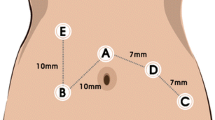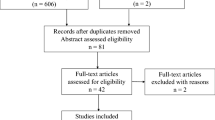Abstract
Background
Colorectal cancer is the third most common cancer worldwide. Current treatment approaches are multidisciplinary, including neoadjuvant chemoradiotherapy for rectal cancer. Several studies have reported an improvement in surgical techniques and in new devices facilitating better pre- and intraoperative staging.
Objectives
Since its first application in 2002, robotic surgery has progressed steadily, offering good surgical results and better oncological outcomes. Currently, many studies and reviews have confirmed its safety and feasibility for colorectal cancer.
Materials and methods
Robotic technology simplifies surgical maneuvers thanks to the three-dimensional magnification and stable vision, convenient mobility of the robotic arms, endowrist instruments with seven degrees of freedom, ambidextrous capability, tremor filtering, and indocyanine green fluorescence imaging.
Results
Regarding the oncological outcome, the robotic technique is equivalent to the laparoscopic approach; however, a lower recurrence rate has been achieved with the robotic approach in extended lymphadenectomy as part of complete mesocolic excision for right colonic cancer and total mesorectal excision for low rectal tumors.
Conclusion
Colorectal robotic surgery has progressively improved worldwide. Its advantages are related not only to better oncological outcomes, but also to improvements in terms of detection, accurate diagnosis, and staging.
Zusammenfassung
Hintergrund
Kolorektale Karzinome sind die dritthäufigsten Karzinome weltweit. Gegenwärtiger Therapiestandard ist die multimodale Behandlung, einschließlich der neoadjuvanten Radiochemotherapie des Rektumkarzinoms. Eine Vielzahl von Studien befasst sich mit der Fortentwicklung der chirurgischen Technik und neuen Gerätschaften auch zur Verbesserung des prä- und intraoperativen Stagings.
Ziel der Arbeit
Die roboterassistierte Chirurgie hat sich seit dem ersten Einsatz in der kolorektalen Chirurgie im Jahr 2002 stetig weiterentwickelt und verbessert. Gegenwärtig haben bereits viele Studien die Sicherheit und Machbarkeit der roboterassistierten Behandlung des kolorektalen Karzinoms belegt.
Material und Methoden
Die Robotertechnologie vereinfacht die chirurgische Präparation aufgrund von 3‑D-Optik mit Vergrößerung auf stabiler Plattform, guter Beweglichkeit der Roboterarme, Endowrist-Instrumenten mit 7 Freiheitsgraden, Beidhändigkeit, Beseitigung von Tremor und Einsatz der Indozyaningrün(ICG)-Fluoreszenz.
Ergebnisse
Bezüglich des onkologischen Ergebnisses ist die Robotertechnologie der laparoskopischen Technik mindestens gleichwertig. Der Einsatz des Roboters vermag bei der erweiterten Lymphadenektomie im Rahmen der kompletten mesokolischen Exzision (CME) wegen eines rechtsseitigen Kolonkarzinoms und bei der totalen mesorektalen Exzision (TME) wegen eines tiefen Rektumkarzinoms die Rezidivrate zu senken.
Schlussfolgerung
Die kolorektale Roboterchirurgie findet weltweit zunehmende Verbreitung: die Vorteile liegen nicht nur im besseren onkologischen Ergebnis, sondern auch in der Verbesserung im Hinblick auf Erkennung, korrekter Diagnosestellung und Staging.
Similar content being viewed by others
References
The National Comprehensive Cancer Network® (NCCN®) NCCN Guidelines Version 2.2015 Updates Colon Cancer
Weber PA, Merola S, Wasielewski A, Wasielewski GH (2002) Telerobotic-assisted laparoscopic right and sigmoid colectomies for benign disease. Dis Colon Rectum 45:1689–1694
Papanikolaou G (2014) Robotic Surgery for Colorectal Cancer: Systematic Review of the Literature. Surg Laparosc Endosc Percutan Tech 24:478–483
Hohenberger W, Weber K, Matzel K et al (2009) Standardized surgery for colonic cancer: complete mesocolic excision and central ligation-technical notes and outcome. Colorectal Dis 11:354–364
Hashiguchi Y, Hase K, Ueno H, Mochizuki H et al (2010) Prognostic significance of the number of lymph nodes examined in colon cancer surgery: clinical application beyond simple measurement. Ann Surg 251(5):872–881
Cho MS, Baek SJ, Hur H, Min BS, Baik SH, Kim NK (2015) Modified Complete Mesocolic Excision With Central Vascular Ligation for the Treatment of Right-sided Colon Cancer. Long-term Outcomes and Prognostic Factors. Ann Surg 261:708–715
Bertelsen CA, Neuenschwander AU, Jansen JE et al (2015) Disease-free survival after complete mesocolic excision compared with conventional colon cancer surgery: a retrospective, population-based study. Lancet Oncol 16:161–168
Bianchi PP, Monsellato I, Petz W (2015) Left colectomy and segmental resections for cancer. In: Spinoglio G (ed) Robotic Surgery: current applications and new trends. Updates in Surgery. Springer, Milan
Heald RJ, Husband EM, Ryall RD (1982) The mesorectum in rectal cancer surgery: the clue to pelvic recurrence? Br J Surg 69:613–616
Luca F, Valvo M, Ghezzi TL et al (2013) Impact of robotic surgery on sexual and urinary function after fully robotic nerve-sparing total mesorectal excision for rectal cancer. Ann Surg 257(4):672–678
Kim JY, Kim N‑K, Lee KY, Hur H, Min BS, Kim JH (2012) A comparative study of voiding and sexual function after total mesorectal excision with autonomic nerve preservation for rectal cancer: laparoscopic versus robotic surgery. Ann Surg Oncol 19:2485–2493
Cho MS, Kim CW, Baek SJ, Hur H, Min BS, Baik SH, Lee KY, Kim NY (2015) Minimally invasive versus open total mesorectal excision for rectal cancer: Long-term results from a case-matched study of 633 patients. Surgery 157:1121–1129
Park EJ, Cho MS, Baek SJ, Hur H et al (2015) Long-term Oncologic Outcomes of Robotic Low Anterior Resection for Rectal Cancer: A Comparative Study With Laparoscopic Surgery. Ann Surg 261:129–137
Collinson FJ, Jayne DG, Pigazzi A, Tsang C, Barrie JM, Edlin R et al (2012) An international, multicentre, prospective, randomised, controlled, unblinded, parallel- group trial of robotic-assisted versus standard laparoscopic surgery for the curative treatment of rectal cancer. Int J Colorect Dis 27:233–241
Formisano G, Marano A, Bianchi PP, Spinoglio G (2015) Challenges with robotic low anterior resection. Minerva Chir 70:341–354
Baik SH, Kwon HY, Kim JS, Hur H, Sohn SK, Cho CH et al (2009) Robotic versus laparoscopic low anterior resection of rectal cancer: short-term outcome of a prospective comparative study. Ann Surg Oncol 16:1480–1487
Midura EF, Hanseman DJ, Hoehn RS et al (2015) The effect of surgical approach on short-term oncologic outcomes in rectal cancer surgery. Surgery 158(2):453–459
Bianchi PP, Ceriani C, Locatelli A, Spinoglio G et al (2010) Robotic versus laparoscopic total mesorectal excision for rectal cancer: a comparative analysis of oncological safety and short-term outcomes. Surg Endosc:1134–1137
Jafari MD, Lee KH, Halabi WJ, Mills SD, Carmichael JC, Pigazzi A (2013) The use of indocyanine green fluorescence to assess anastomotic perfusion during robotic assisted laparoscopic rectal surgery. Surg Endosc 27:3003–3008
Nishigori N, Koyama F, Nakagawa T, Inoue T et al (2016) Visualization of lymph/blood flow in laparoscopic colorectal cancer surgery by ICG Fluorescence Imaging (lap-IGFI). Ann Surg Oncol 23:S266–S274
Hellan M, Spinoglio G, Pigazzi A, Lagares-Garcia JA (2014) The influence of fluorescence imaging on the location of bowel transection during robotic left-sided colorectal surgery. Surg Endosc : doi:10.1007/s00464-013-3377-6
Meijerink WJ et al (2009) New horizons in colorectal cancer surgery. Surg Endosc 23:1–3
Van der Zaag ES, Bouma WH, Peters HM, Bemelman WA, Buskens CJ (2012) Implications of sentinel lymph node mapping on nodal staging and prognosis in colorectal cancer. Colorectal Dis 14:684–690
Hirche C, Mohr Z, Kneif S, Doniga S, Murawa D, Strik M, Hünerbein M (2012) Ultrastaging of colon cancer by sentinel node biopsy using fluorescence navigation with indocyanine green. Int J Colorectal Dis 27(3):319–324
Nagata J, Fukunaga Y, Konishi T et al (2016) Colonic marking with near-infrared, light-emitting, diode-activated Indocyanine green for laparoscopic colorectal surgery. dis Colon Rectum 59:e14–e18
Xu JM, Wei Y, Wang XY, Fan H et al (2015) Robot-assisted one-stage resection of rectal cancer with liver and lung metastases. World J Gastroenterol 21(9):2848–2853
Author information
Authors and Affiliations
Corresponding author
Ethics declarations
Conflict of interest
G. Spinoglio MD is proctor for Intuitive Surgical Inc (Sunnyvale CA, USA) for colorectal robotic surgery. P. Bellora MD and M. Monni MD have not conflict of interest to declare.
I confirm that the accompanying manuscript does not include studies on humans or animals.
The supplement containing this article is not sponsored by industry.
Additional information
The German version of this article can be found under doi: 10.1007/s00104-016-0238-6.
Rights and permissions
About this article
Cite this article
Spinoglio, G., Bellora, P. & Monni, M. Robotic technology for colorectal surgery. Chirurg 88 (Suppl 1), 29–33 (2017). https://doi.org/10.1007/s00104-016-0208-z
Published:
Issue Date:
DOI: https://doi.org/10.1007/s00104-016-0208-z




